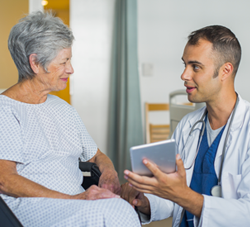
Better division of labour between administrative staff and medical caregivers means that more time can be allocated to interaction with patients.
Chatting and being kept informed are among patients' legitimate expectations of their caregivers. This takes time; time which can be spared by establishing a better balance of activities.
A call for projects will be launched in 2015 to build momentum. Successful projects should focus on freeing up time for spending with patients, and must be able to be quickly implemented and assessed.
Action 06.1 : Simplifying processes
Une partie croissante du temps consacré aux activités non strictement médicales pourrait être destinée aux patients en simplifiant les processus cliniques et administratifs. Pour y parvenir, les HUG s’inspireront de la méthode de gestion Lean, qui a fait ses preuves dans l’industrie, mais aussi dans le secteur hospitalier, notamment au Canada. Cette théorie se concentre sur la recherche de la performance par l’élimination de tout gaspillage, ce qui peut également se traduire par une redistribution de certaines tâches.
Les méthodes développées dans le cadre d’un projet déjà en cours, qui a pour objectif d’améliorer les processus de support, seront utilisées. Il en va de même des enseignements tirés du projet d’automatisation des processus administratifs.
Action 06.2 : Including patients in discussions about their care
Along with a better distribution of tasks, the way in which certain medical and nursing tasks are carried out will also be revised, to optimise contact time with patients and relatives. For example, in the future, information exchanged orally between medical and nursing teams will be able to be passed on at the bedside rather than in an office. This will enable the patient to actively participate in discussions, ask questions and be fully aware of the different stages of their treatment. The patient may also be accompanied by a friend or relative during the interview.
Action 06.3 : Improving patient-caregiver communication
The time gained with the patient really comes into its own when it allows for quality interaction and constructive exchanges. To make sure that this closer contact is actually useful and that the patient's hospital experience is a positive one, it is important that we strengthen the technical skills of staff when it comes to communicating with patients and their relatives.